Integrating Spatial and Non-Spatial Dimensions to Measure Urban Fire Service Access
Abstract
1. Introduction
2. Review of Key Improvements for the Floating Catchment Area Methods
2.1. Improvement 1: Addition of Distance Decay Function
2.2. Improvement 2: Addition of Service Competition Model
2.3. Improvement 3: Addition of Non-Spatial Factors
3. The Proposed F-2SFCA Method for Fire Service
3.1. Measuring Fire Service Accessibility Integrating Spatial and Non-Spatial Factors
3.1.1. Modeling Spatial Effect Utilizing Spatial Interaction Model
3.1.2. Assessing Non-Spatial Effect by Quantifying Service Needs
3.2. Integrating Spatial and Non-Spatial Effects within the 2SFCA Method
3.3. Measuring Facility Busyness
4. Case Study
4.1. Study Area and Datasets
4.2. Experimental Results and Analysis
4.3. Evaluating the Performance of F-2SFCA by Inverted 2SFCA
5. Conclusions
Author Contributions
Funding
Acknowledgments
Conflicts of Interest
References
- Wiśniewski, S. The use of network analyst tool and 2SFCA method to assess fire service effectiveness in a city, as exemplified by Łódź. Geomat. Landmanag. Landsc. 2017, 147–158. [Google Scholar] [CrossRef]
- Pill, R. Accessibility and utilization: Geographical perspectives on health care delivery. J. R. Coll. Gen. Practition. 1984, 34, 452. [Google Scholar]
- Pooler, J. Measuring geographical accessibility: A review of current approaches and problems in the use of population potentials. Geoforum 1987, 18, 269–289. [Google Scholar] [CrossRef]
- Shen, Q. Location characteristics of inner-city neighborhoods and employment accessibility of low-income workers. Environ. Plan. B 1998, 25, 345–365. [Google Scholar] [CrossRef]
- Luo, W.; Qi, Y. An enhanced two-step floating catchment area (E2SFCA) method for measuring spatial accessibility to primary care physicians. Health Place 2009, 15, 1100–1107. [Google Scholar] [CrossRef] [PubMed]
- Luo, W.; Wang, F.H. Measures of spatial accessibility to health care in a GIS environment: Synthesis and a case study in the Chicago region. Environ. Plan. B 2003, 30, 865–884. [Google Scholar] [CrossRef]
- Mcgrail, M.R.; Humphreys, J.S. Measuring spatial accessibility to primary care in rural areas: Improving the effectiveness of the two-step floating catchment area method. Appl. Geogr. 2009, 29, 533–541. [Google Scholar] [CrossRef]
- McGrail, M.R.; Humphreys, J.S. A new index of access to primary care services in rural areas. Aust. N. Zeal. J. Public Health 2009, 33, 418–423. [Google Scholar] [CrossRef]
- Langford, M.; Higgs, G.; Fry, R. Using floating catchment analysis (FCA) techniques to examine intra-urban variations in accessibility to public transport opportunities: The example of Cardiff, Wales. J. Transp. Geogr. 2012, 25, 1–14. [Google Scholar] [CrossRef]
- Dony, C.C.; Delmelle, E.M.; Delmelle, E.C. Re-conceptualizing accessibility to parks in multi-modal cities: A variable-width floating catchment area (VFSCA) method. Landsc. Urban Plan. 2015, 143, 90–99. [Google Scholar] [CrossRef]
- Dai, D. Racial/ethnic and socioeconomic disparities in urban green space accessibility: Where to intervene? Landsc. Urban Plan. 2011, 102, 234–244. [Google Scholar] [CrossRef]
- Ngui, A.N.; Apparicio, P. Optimizing the two-step floating catchment area method for measuring spatial accessibility to medical clinics in Montreal. BMC Health Serv. Res. 2011, 11, 1–12. [Google Scholar] [CrossRef] [PubMed]
- Dai, D.; Wang, F. Geographic disparities in accessibility to food stores in southwest Mississippi. Environ. Plan. B 2011, 38, 659–677. [Google Scholar] [CrossRef]
- Wan, N.; Zhou, B.; Sternberg, T. A three-step floating catchment area method for analyzing spatial access to health services. Int. J. Geogr. Inf. Sci. 2012, 26, 1073–1089. [Google Scholar] [CrossRef]
- Luo, W.; Whippo, T. Variable catchment sizes for the two-step floating catchment area (2SFCA) method. Health Place 2012, 18, 789–795. [Google Scholar] [CrossRef] [PubMed]
- Delamater, P.L. Spatial accessibility in suboptimally configured health care systems: A modified two-step floating catchment area (M2SFCA) metric. Health Place 2013, 24, 30–43. [Google Scholar] [CrossRef]
- Kocatepe, A.; Ulak, M.B.; Ozguven, E.E.; Horner, M.W.; Arghandeh, R. Socioeconomic characteristics and crash injury exposure: A case study in Florida using two-step floating catchment area method. Appl. Geogr. 2017, 87, 207–221. [Google Scholar] [CrossRef]
- Wang, F.H. Inverted Two-Step Floating catchment area method for measuring facility busyness. Prof. Geogr. 2017, 69, 251–260. [Google Scholar]
- Luo, J. Integrating the Huff model and floating catchment area methods to analyze spatial access to healthcare services. Trans. GIS 2014, 18, 436–448. [Google Scholar] [CrossRef]
- Kanuganti, S.; Sarkar, A.K.; Singh, A.P. Quantifying accessibility to health care using two-step floating catchment area method (2SFCA): A case study in Rajasthan. Transp. Res. Procedia 2016, 17, 391–399. [Google Scholar] [CrossRef]
- Cheng, G.; Zeng, X.; Duan, L.; Lu, X.; Sun, H.; Jiang, T.; Li, Y. Spatial difference analysis for accessibility to high level hospitals based on travel time in Shenzhen, China. Habitat Int. 2016, 53, 485–494. [Google Scholar] [CrossRef]
- Khan, A.A. An integrated approach to measuring potential spatial access to health care services. Socio-Econ. Plan. Sci. 1992, 26, 275–287. [Google Scholar] [CrossRef]
- Wang, F.H. Measurement, optimization, and impact of health care accessibility: A methodological review. Ann. Assoc. Am. Geogr. 2012, 102, 1104–1112. [Google Scholar] [CrossRef]
- Li, H.P.; Wang, Q.F.; Shi, W.; Deng, Z.W.; Wang, H.W. Residential clustering and spatial access to public services in Shanghai. Habitat Int. 2014, 46, 119–129. [Google Scholar] [CrossRef]
- Tang, J.H.; Chiu, Y.H.; Chiang, P.H.; Su, M.D.; Chan, T.C. A flow-based statistical model integrating spatial and non-spatial dimensions to measure healthcare access. Health Place 2017, 47, 126–138. [Google Scholar] [CrossRef]
- Zhao, Z.Q.; He, B.J.; Li, L.G.; Wang, H.B.; Darko, A. Profile and concentric zonal analysis of relationships between land use/land cover and land surface temperature: Case study of Shenyang, China. Energy Build. 2017, 155, 282–295. [Google Scholar] [CrossRef]
- Jennings, C.R. Social and economic characteristics as determinants of residential fire risk in urban neighborhoods: A review of the literature. Fire Saf. J. 2013, 62, 13–19. [Google Scholar] [CrossRef]
- Nanjing News. Government Report: The 13th Five-Year Plan for City Fire Plan of Nanjing. Available online: http://www.nanjing.gov.cn/xxgk/szf.htm (accessed on 3 December 2015).
- Helling, A.; Sawicki, D.S. Race and residential accessibility to shopping and services. Hous. Policy Debate 2003, 14, 69–101. [Google Scholar] [CrossRef]
- Larsen, K.; Gilliland, J. Mapping the evolution of ‘food deserts’ in a Canadian city: Supermarket accessibility in London, Ontario, 1961–2005. Int J. Health Geogr. 2008, 7, 16. [Google Scholar] [CrossRef]
- Standards for the Construction of Urban Fire Stations. Available online: http://119.gov.cn/xiaofang/bzhgzdt/35172.htm (accessed on 15 July 2016).
- Fire Protection Law of the People’s Republic of China. Available online: http://www.119.gov.cn/xiaofang/bzfg/17213.htm (accessed on 9 June 2015).
- Dai, D.J. Black residential segregation, disparities in spatial access to health care facilities, and late-stage breast cancer diagnosis in metropolitan Detroit. Health Place 2010, 16, 1038–1052. [Google Scholar] [CrossRef]
- Guagliardo, M.F. Spatial accessibility of primary care: Concepts, methods and challenges. Int. J. Health Geogr. 2004, 3, 3. [Google Scholar] [CrossRef] [PubMed]
- Ni, J.H.; Wang, J.J.; Rui, Y.; Qian, T.; Wang, J. An Enhanced Variable Two-Step Floating Catchment Area Method for Measuring Spatial Accessibility to Residential Care Facilities in Nanjing. Int. J. Environ. Res. Public Health 2015, 12, 14490–14504. [Google Scholar] [CrossRef] [PubMed]
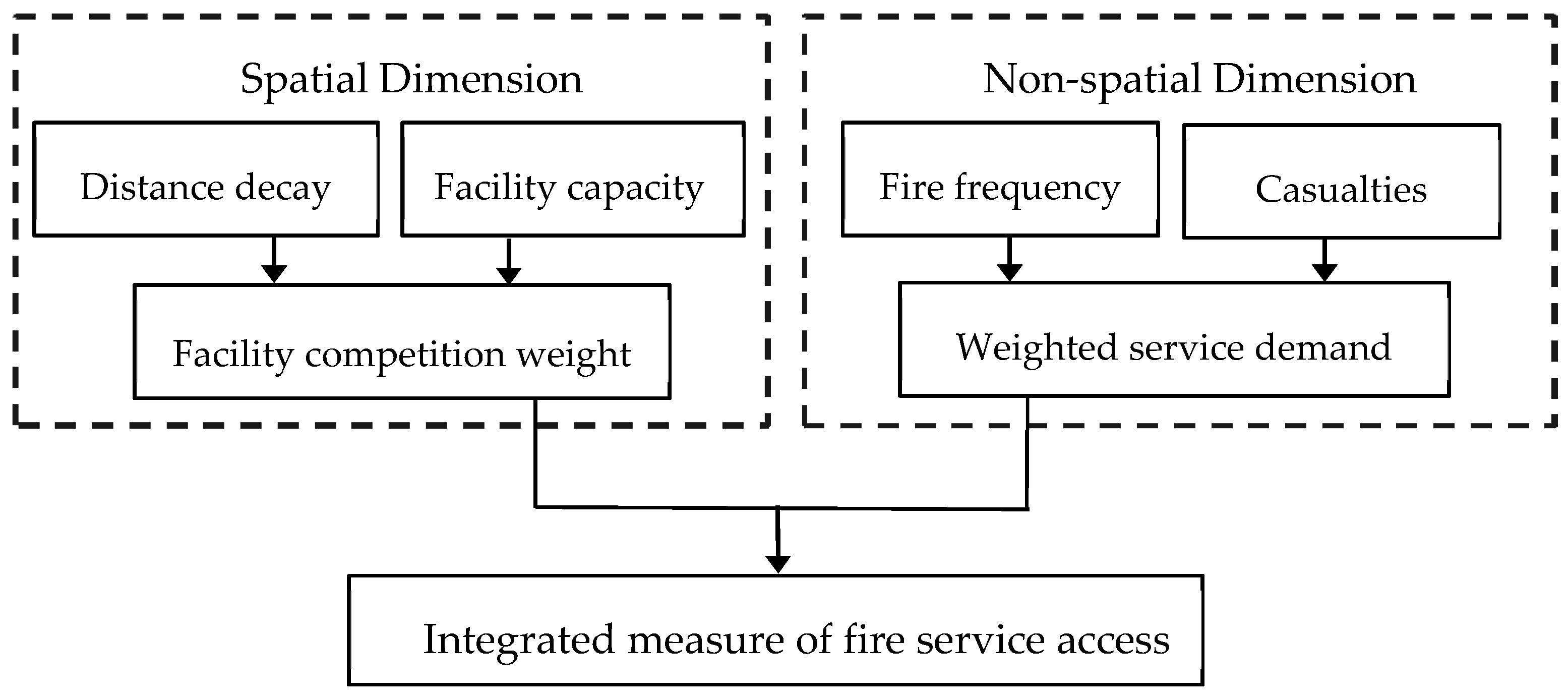

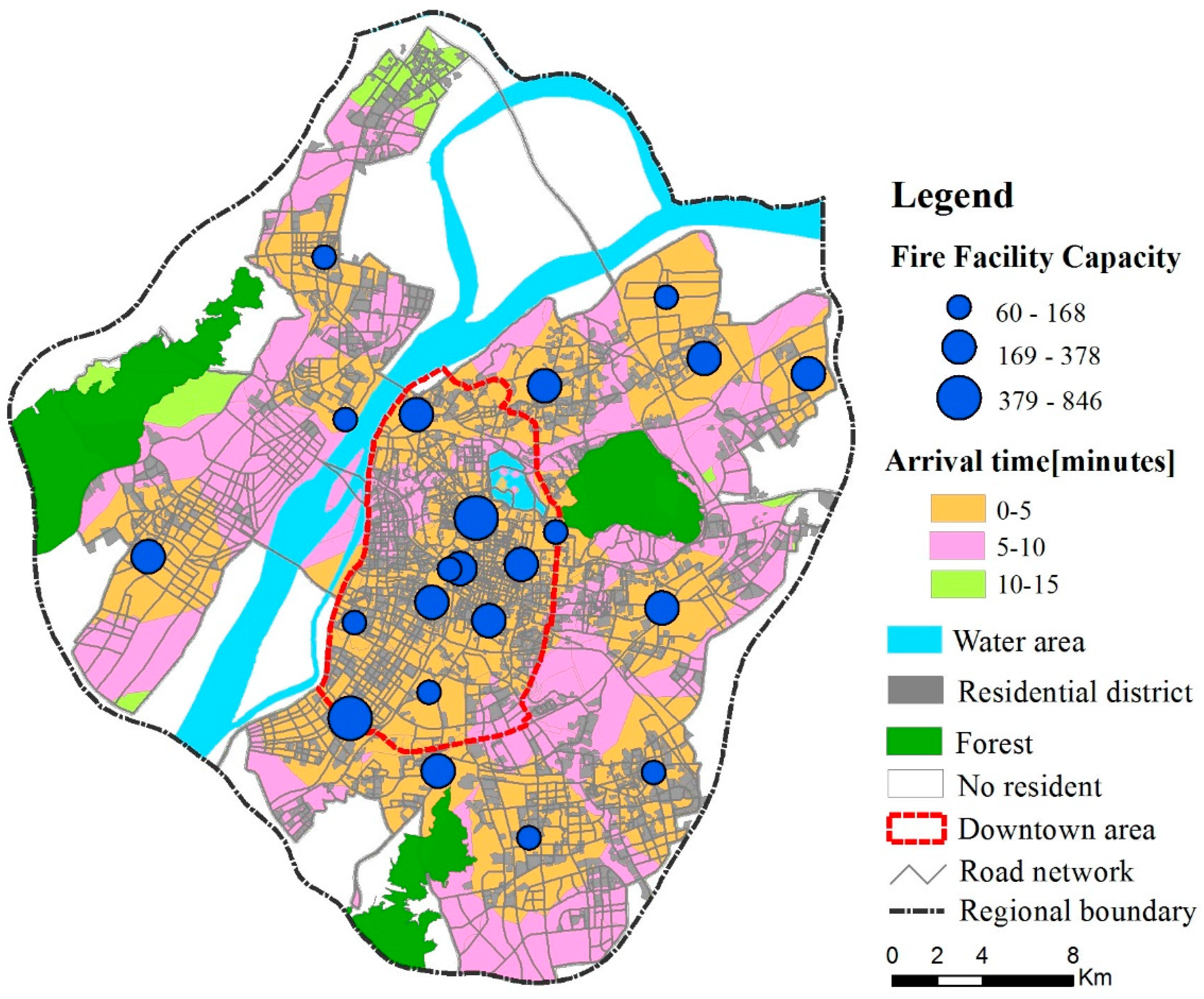
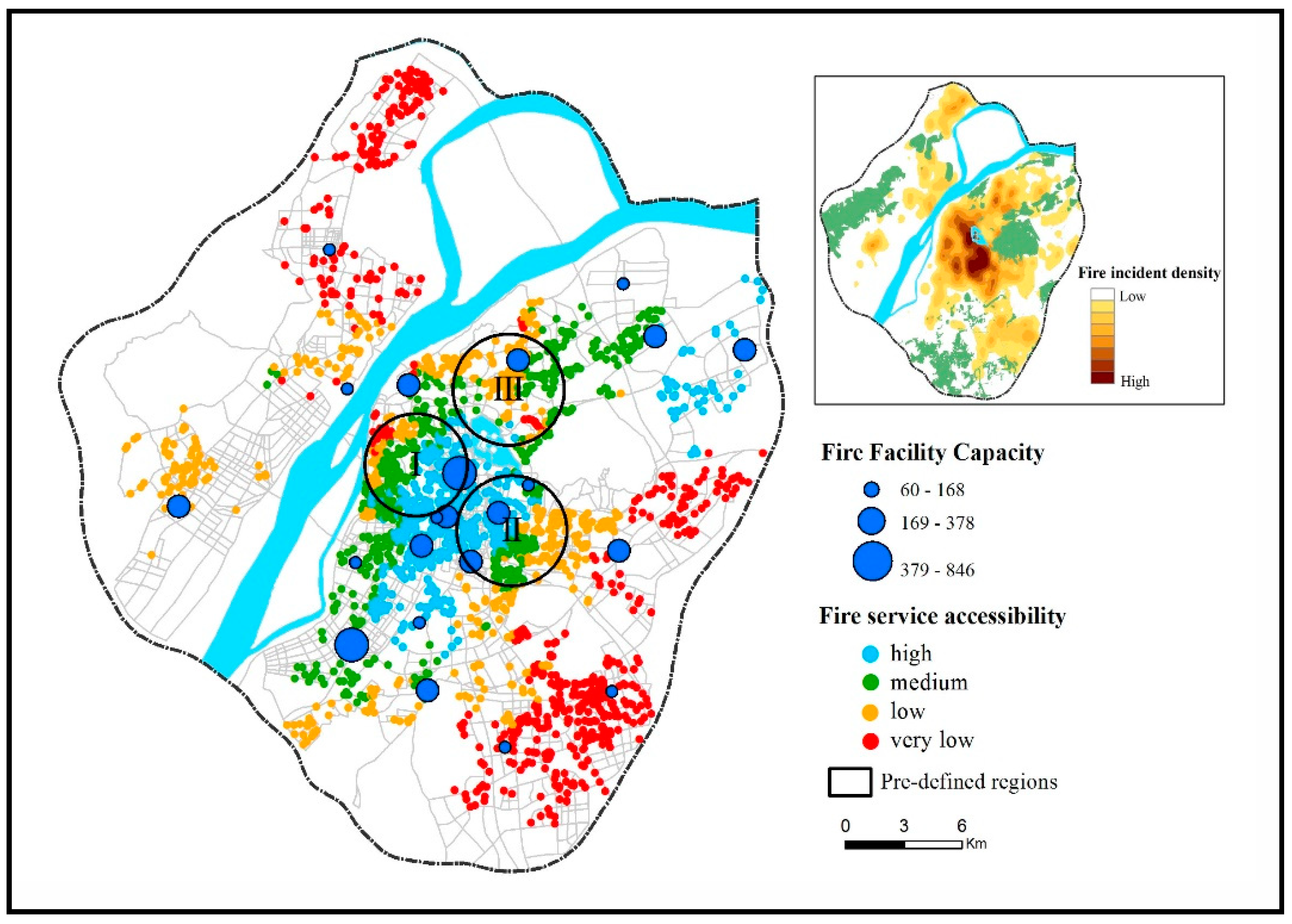
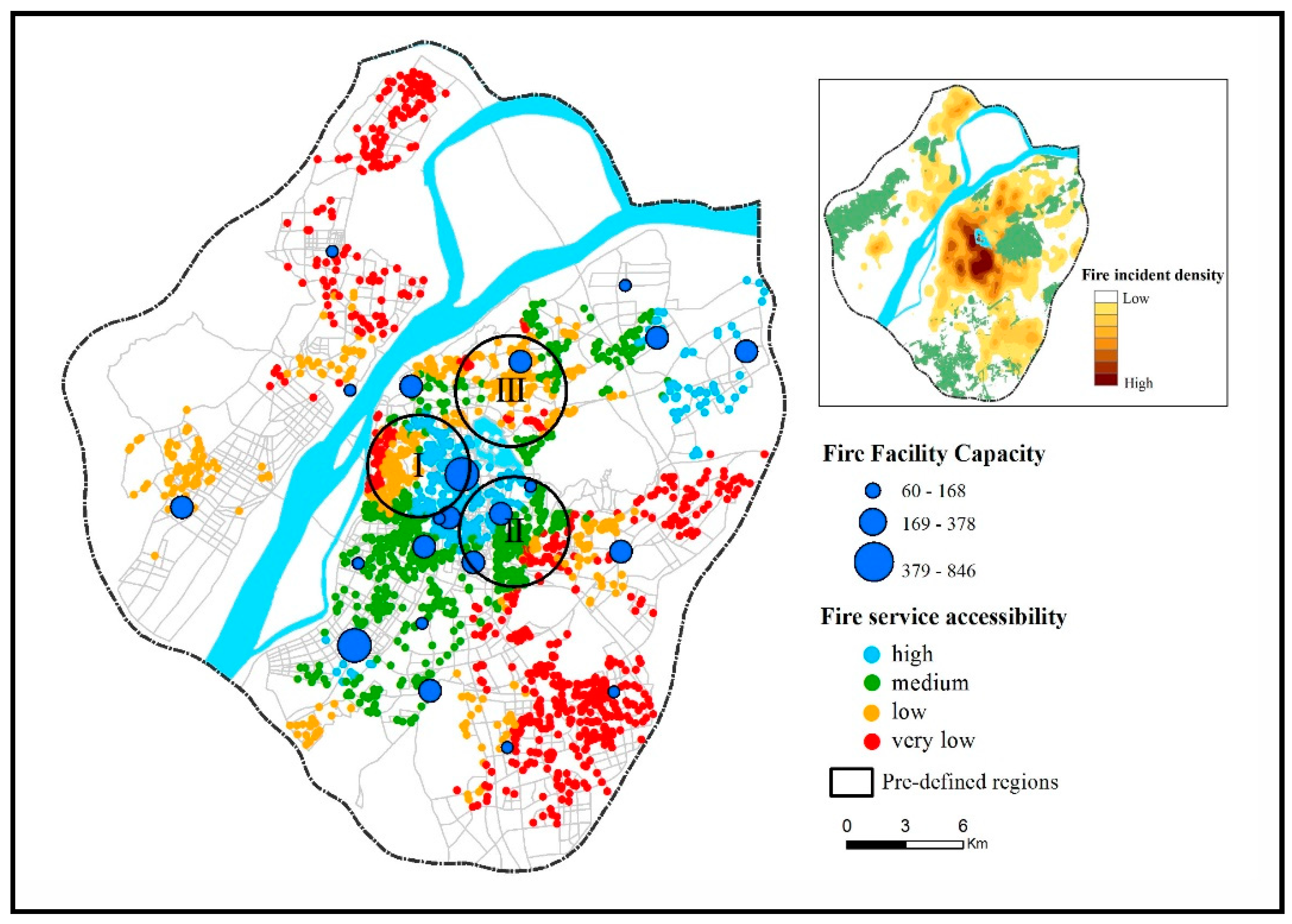
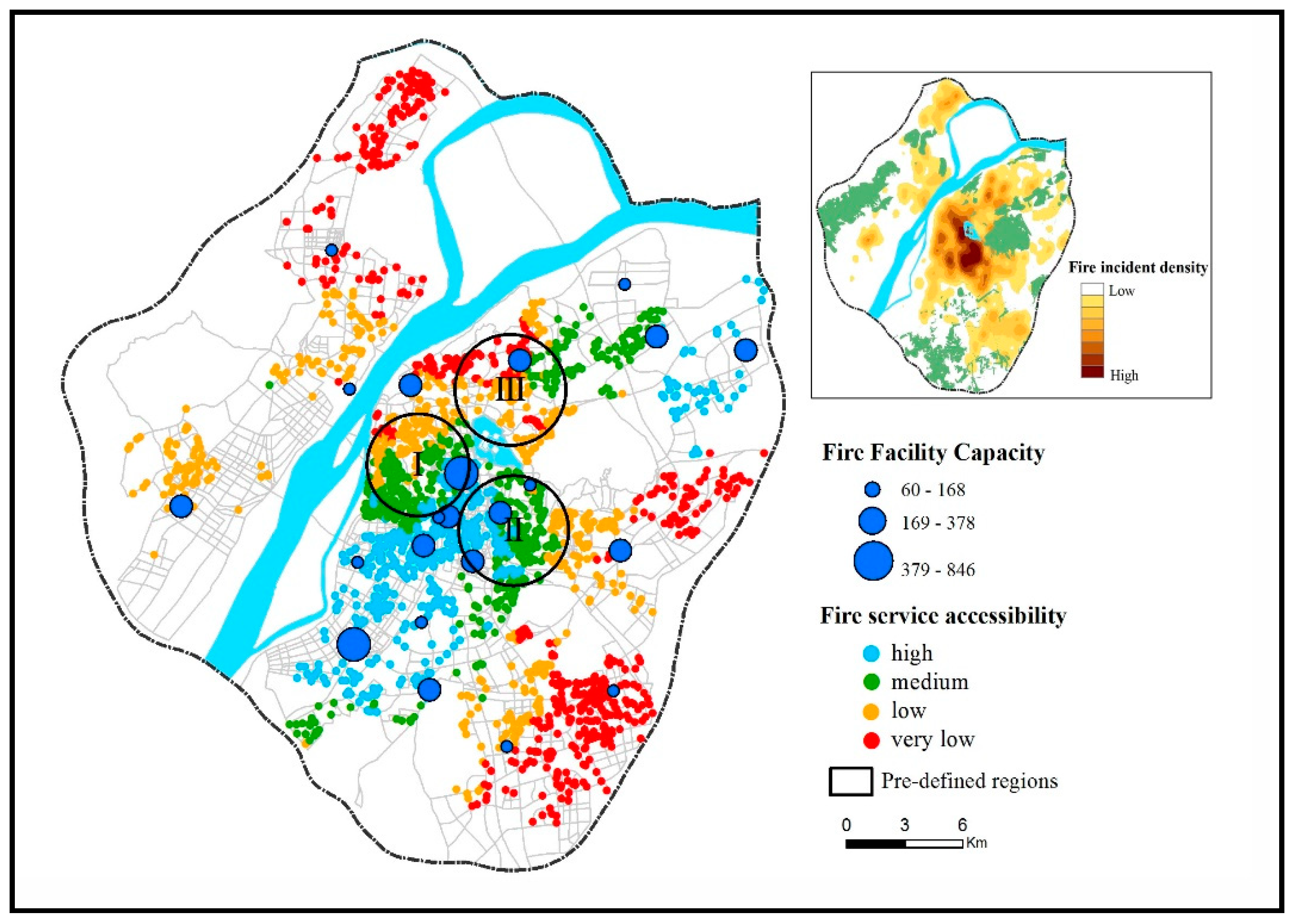
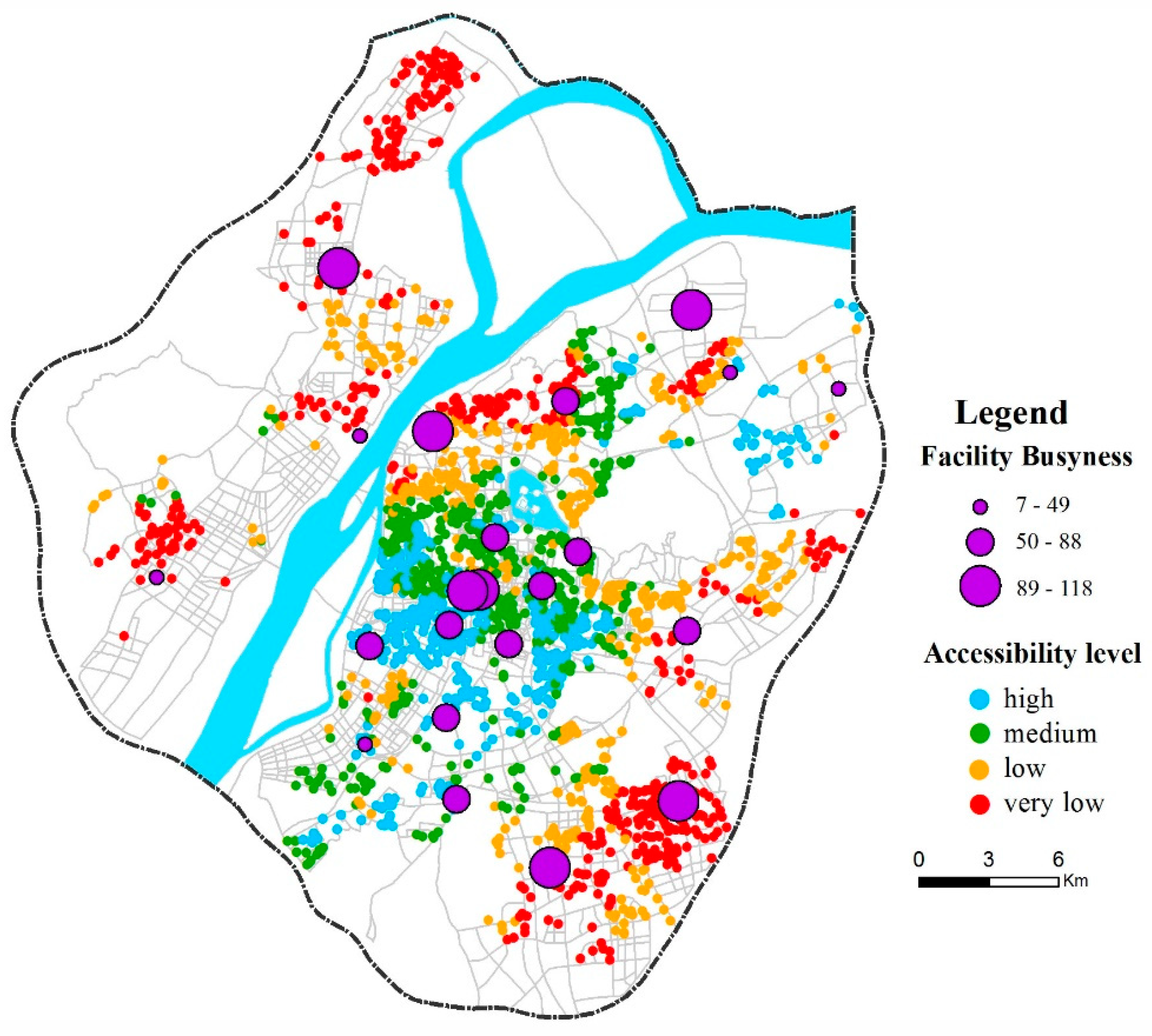
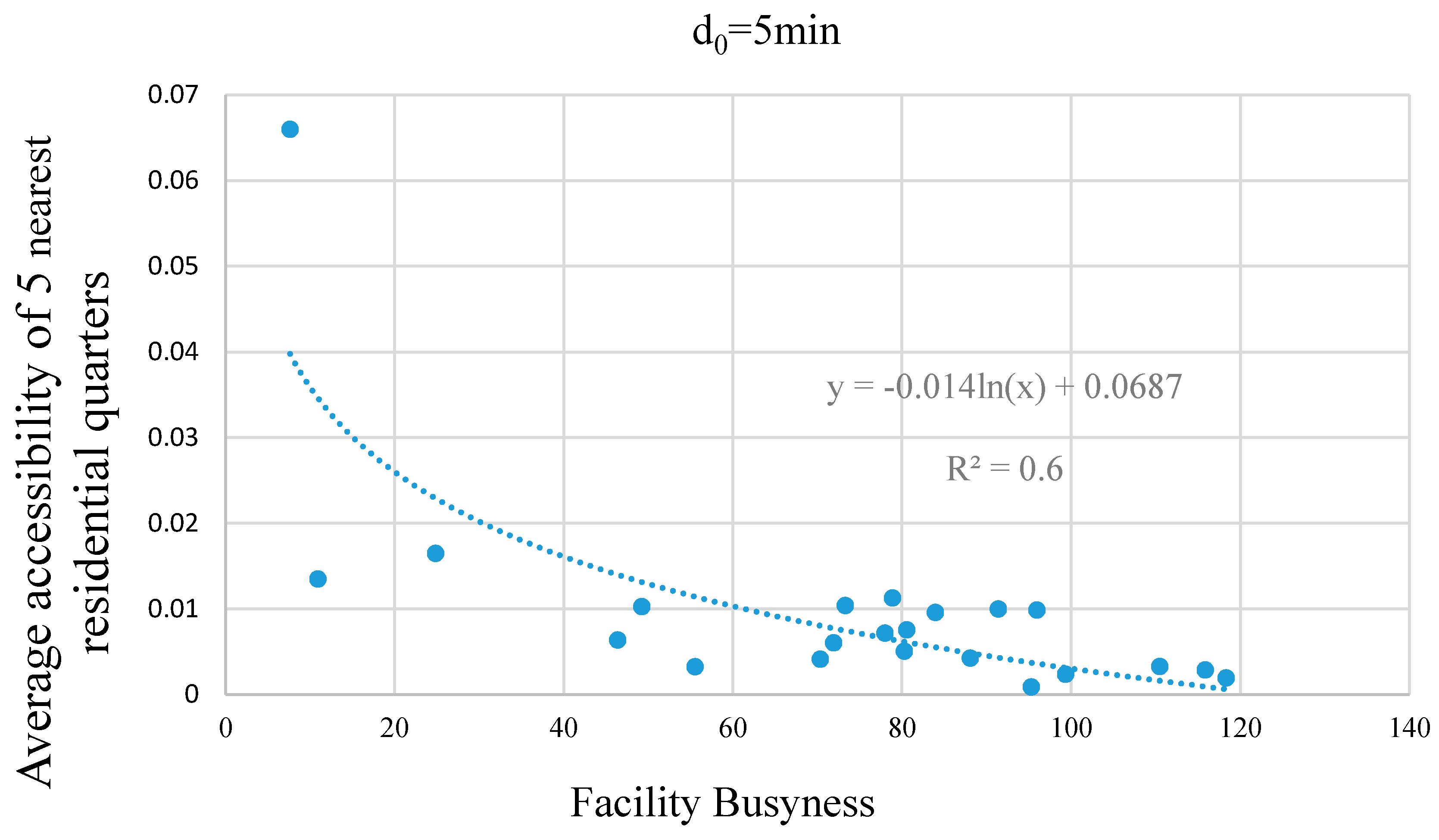
| 2SFCA | i2SFCA | |
|---|---|---|
| Purpose | Measuring service accessibility at a demand location (i) | Measuring busyness at a supply location (j) |
| Step 1 | Calculate the supply-demand ratio : | Calculate the demand-supply ratio : |
| Step 2 | Acquire the service accessibility : | Acquire the facility busyness : |
| Conclusion | Average accessibility and busyness are reciprocal of each other | |
| District | Population | F1 | F2 | F3 | F4 | F5 |
|---|---|---|---|---|---|---|
| Region I | 391,548 | 84 | 1 | 2 | 2.60 km | 215 |
| Region II | 399,867 | 96 | 2 | 5 | 2.11 km | 338 |
| Region III | 296,376 | 42 | 0 | 1 | 2.45 km | 463 |
| Accessibility Level | The Original 2SFCA | The 2SFCA Incorporating Additional Spatial Factors | The F-2SFCA | ||||||
|---|---|---|---|---|---|---|---|---|---|
| F4 | F1 % | F5 | F4 | F1 % | F5 | F4 | F1 % | F5 | |
| Region I | |||||||||
| high | 1.50 km | 52% | 81 | 1.7 km | 64% | 107 | 1.03 km | 14.1% | 20 |
| medium | 3.18 km | 34% | 80 | 2.9 km | 6.5% | 6 | 2.65 km | 32% | 107 |
| low | 4.23 km | 10.3% | 25 | 3.56 km | 16.7% | 50 | 3.37 km | 52% | 53 |
| very low | 3.61 km | 3.7% | 29 | 4.38 km | 12.8% | 52 | 3.52 km | 1.9% | 35 |
| Region II | |||||||||
| high | 1.33 km | 60% | 142 | 1.1 km | 64.7% | 159 | 1.65 km | 45% | 126 |
| medium | 2.21 km | 29.2% | 157 | 2.6 km | 30.6% | 132 | 2.18 km | 28.8% | 172 |
| low | 3.32 km | 10.8% | 39 | 3.74 km | 4.7% | 47 | 3.53 km | 26.2% | 40 |
| very low | - | - | - | - | - | - | - | - | - |
| Region III | |||||||||
| high | - | - | - | - | - | - | - | - | |
| medium | 2.53 km | 43% | 252 | 2.56 km | 42% | 247 | 2.49 km | 24.5% | 77 |
| low | 2.92 km | 50% | 196 | 2.19 km | 38% | 182 | 2.12 km | 42% | 241 |
| very low | 4.11 km | 7% | 15 | 3.75 km | 20% | 34 | 2.67 km | 33.5% | 145 |
© 2019 by the authors. Licensee MDPI, Basel, Switzerland. This article is an open access article distributed under the terms and conditions of the Creative Commons Attribution (CC BY) license (http://creativecommons.org/licenses/by/4.0/).
Share and Cite
Xia, Z.; Li, H.; Chen, Y.; Yu, W. Integrating Spatial and Non-Spatial Dimensions to Measure Urban Fire Service Access. ISPRS Int. J. Geo-Inf. 2019, 8, 138. https://doi.org/10.3390/ijgi8030138
Xia Z, Li H, Chen Y, Yu W. Integrating Spatial and Non-Spatial Dimensions to Measure Urban Fire Service Access. ISPRS International Journal of Geo-Information. 2019; 8(3):138. https://doi.org/10.3390/ijgi8030138
Chicago/Turabian StyleXia, Zelong, Hao Li, Yuehong Chen, and Wenhao Yu. 2019. "Integrating Spatial and Non-Spatial Dimensions to Measure Urban Fire Service Access" ISPRS International Journal of Geo-Information 8, no. 3: 138. https://doi.org/10.3390/ijgi8030138
APA StyleXia, Z., Li, H., Chen, Y., & Yu, W. (2019). Integrating Spatial and Non-Spatial Dimensions to Measure Urban Fire Service Access. ISPRS International Journal of Geo-Information, 8(3), 138. https://doi.org/10.3390/ijgi8030138





